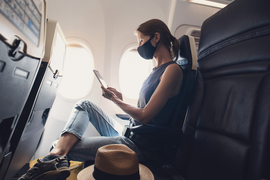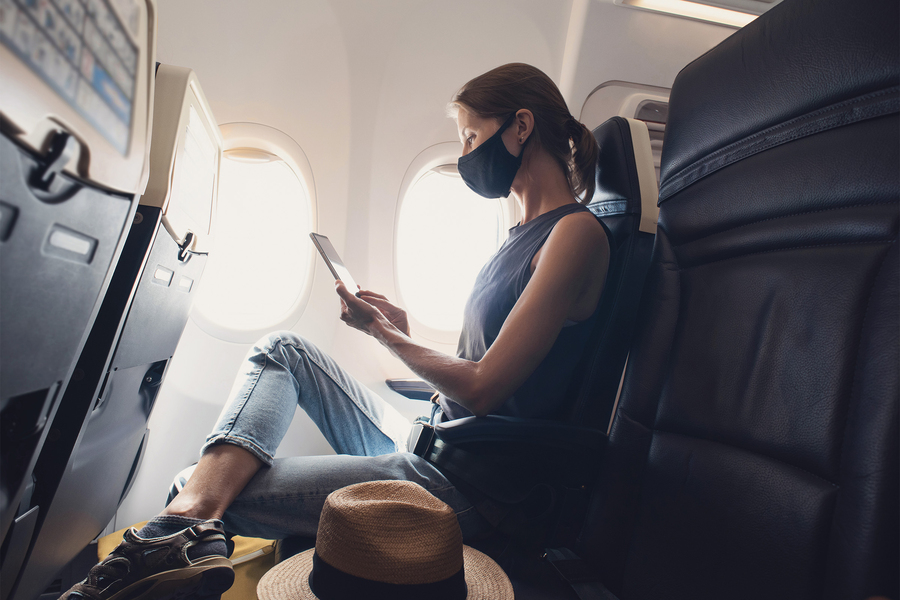What are the chances you will contract Covid-19 on a plane flight? A study led by MIT scholars offers a calculation of that for the period from June 2020 through February 2021. While the conditions that applied at that stage of the Covid-19 pandemic differ from those of today, the study offers a method that could be adapted as the pandemic evolves.
The study estimates that from mid-2020 through early 2021, the probability of getting Covid-19 on an airplane surpassed 1 in 1,000 on a totally full flight lasting two hours at the height of the early pandemic, roughly December 2020 and January 2021. It dropped to about 1 in 6,000 on a half-full two-hour flight when the pandemic was at its least severe, in the summer of 2020. The overall risk of transmission from June 2020 through February 2021 was about 1 in 2,000, with a mean of 1 in 1,400 and a median of 1 in 2,250.
To be clear, current conditions differ from the study’s setting. Masks are no longer required for U.S. domestic passengers; in the study’s time period, airlines were commonly leaving middle seats open, which they are no longer doing; and newer Covid-19 variants are more contagious than the virus was during the study period. While those factors may increase the current risk, most people have received Covid-19 vaccinations since February 2021, which could serve to lower today’s risk — though the precise impact of those vaccines against new variants is uncertain.
Still, the study does provide a general estimate about air travel safety with regard to Covid-19 transmission, and a methodology that can be applied to future studies. Some U.S. carriers at the time stated that onboard transmission was “virtually nonexistent” and “nearly nonexistent,” but as the research shows, there was a discernible risk. On the other hand, passengers were not exactly facing coin-flip odds of catching the virus in flight, either.
“The aim is to set out the facts,” says Arnold Barnett, a management professor at MIT and aviation risk expert, who is co-author of a recent paper detailing the study’s results. “Some people might say, ‘Oh, that doesn’t sound like very much.’ But if we at least tell people what the risk is, they can make judgments.”
As Barnett also observes, a round-trip flight with a change of planes and two two-hour segments in each direction counts as four flights in this accounting, so a 1 in 1,000 probability, per flight, would lead to approximately a 1 in 250 chance for such a trip as a whole.
All told, given about 204 million U.S. domestic airline passengers from June 2020 through February 2021, the researchers estimate that about 100,000 cases of Covid-19 were transmitted on flights during that time.
The paper, “Covid-19 infection risk on U.S. domestic airlines,” appears in advance online form this month in the journal Health Care Management Science. The authors are Barnett, who is the George Eastman Professor of Management Science in the MIT Sloan School of Management; and Keith Fleming, a student from MIT Sloan’s master’s program in business analytics.
Barnett is a longtime expert in airline safety who has analyzed the long-term reduction in aviation crashes in recent decades, among other topics. The current study about transmission of the Covid-19 virus was spurred by an airline policy change from early in the pandemic — Delta Air Lines started leaving open the middle seats on domestic flights, in order to de-densify its planes, a practice that some other airlines followed for a while. (Delta and all other airlines are no longer using this policy.)
To conduct the study, Barnett and Fleming amalgamated public health statistics about Covid-19 prevalence, data from peer-reviewed studies about Covid-19 contagion mechanisms, data about the spread of viruses on airlines generally and the spread of Covid-19 on international airlines, and some available industry data about seat-occupancy rates on U.S. domestic jet flights. They then estimated transmission risks on U.S. domestic airlines through extensive modeling.
The researchers used a two-hour flight for their estimates because that is about the average duration of a domestic flight in the U.S. As their airplane settings, the scholars used a Boeing 737 and Airbus A320, workhorse planes in the U.S. with a single aisle, three seats on either side, and typical capacities of about 175 passengers. Most such planes do have high-functioning HEPA air-purification systems, which help reduce the transmission risk of airborne illnesses.
Using the prevalence of Covid-19 in the U.S. as a starting point, and integrating airborne transmission data, Barnett and Fleming modeled what would likely happen on flights filled with a wide variety of passenger loads. The modeling includes a series of adjustments to make the passenger profile as realistic as possible. For instance, airline passengers are a bit more affluent than the U.S. population as a whole, and Covid-19 has affected more affluent populations slightly less than other social groups, so those things are quantified in the study, among other factors.
Ultimately Barnett and Fleming did find a notable dropoff in transmission risk when planes have fewer people on them — whether having fewer passengers is due to lack of demand, or because airlines were leaving middle seats open. While it is true that leaving middle seats open does not eliminate all proximity with all other passengers, it does reduce the extent of close proximity with others, and thus appears to lower the overall transmission risk.
“The [medical] literature suggests the proximity matters,” Barnett says.
As Barnett readily notes, pandemic circumstances and airline policies keep evolving, meaning that their estimates for the 2020-2021 period in the study may not translate precisely to the summer of 2022. Even despite the availability of vaccines, he believes the reduced amount of masking, the more-crowded flights, and easy transmissibility of current variants all mean that risks could have increased.
“If we were to do an estimate of the chances of infection now, it could be considerably higher,” Barnett says.
Still, he adds, the approach used in this paper could readily be adapted to updated studies about in-flight transmission risks, for Covid-19 or other viruses.
“Modeling like that presented here could help in assessing the changed situation, much as the general approach might help in connection with a future pandemic,” Barnett and Fleming write in the paper.
Open access funding making the paper free for readers was provided by MIT Libraries.











